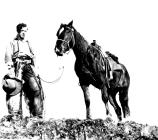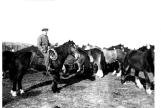14
Plowing with a Four Horse Team at 'Lyon Cross Ranch'1920
Drumheller Region, Alberta
 Credits:
Credits:Russell Family Collection
15
Author: Mary (Galloway-Beckwith) RussellExcerpts from a letter written to the Calgary Daily Herald Newspaper
January 25, 1936, Drumheller, Alberta
"After the country became settled the days for range cattle ended in 1910. Mr Russell sold his cattle to William Campbell of Dorothy, [Alberta], bought a section of land north of the Red Deer River still holding ¾ sections on the south side of the river. In 1911 he…built a house on his farm & moved into this house which is still [standing in 2005].
During Mr. Russell's farming days, he did not grow much wheat; he was too fond of cattle & horses and would rather grow plenty of feed for stock. There was never a car load of wheat shipped from his farm when he was living."
16
Harvesting at the 'Lyon Cross Ranch'1920
Drumheller Region, Alberta
 Credits:
Credits:Russell Family Collection
17
Norman (Beckwith) Russell, son of James and Mary (Galloway-Beckwith) RussellTranscript from a conversation with Nora Woloschuk
1994, Drumheller, Alberta
Nora Woloschuk: "Where were you born?"
Norman Russell: "I was born in the old general hospital in Calgary. I came to Drumheller in 1906 in a wagon when I was six months old with my mother and my brother. It took us three days to come."
Nora: "Three days from Calgary, to here? How long does it take by car now?"
Norman: "A little over an hour."
18
Horses on the Prairie1910
Hand Hills, Alberta
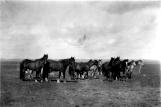 Credits:
Credits:Photographer: Sterrie Lenfesty, Lenfesty Family Collection
19
Johnny Caswell in conversation with Carrie TroutJune 2005, Drumheller, Alberta
Johnny Caswell: "A story, it does include a horse but the horse is not the focal, no not the main part. It's just the situation.
There was a family that was right at the top of the hill coming up out of Drumheller. There is still a house there and what have you, but they homesteaded there. They had…or I knew two boys and a girl. And, Harold was the oldest and Kathleen was the girl in between and she was born in 1900, so they were here early all right. And Melvin, he was born some time later than them, but I don't have his birth date at all.
But you know, here in the deep grass and riding an old workhorse around the survey, he was going to be a cowboy. That's all there was to it. And…he liked to come down and spend time with my Dad, you know. He could tell Dad his dreams you know and stuff. And Dad wouldn't laugh at him. And so he just…
Dad had a really, really nice black team. You know there were 'Cayouse' mares and a registered stallion. But, the mare was particularly nice and she was, she was light enough to ride you know, he wouldn't ride her now you know because she had big feet and what have you.
But she had a nice way of going, so he wanted to buy her from Dad. And Dad said 'Well ya.' He said 'You get yourself outfitted up.' He said 'And I'll sell you that mare.'
So the boy, he got on a train and went to Calgary and he bought a saddle and he bought himself a pair of gold angora chaps. And, this was 1918, he never came home. He got the flu and died right there in Calgary."
20
Boys Sitting at Barn Door1915
Hand Hills, Alberta
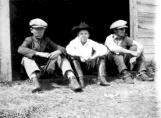 Credits:
Credits:Photographer: Sterrie Lenfesty, Lenfesty Family Collection
21
Johnny Caswell in conversation with Carrie TroutJune 2005, Drumheller, Alberta
Carrie Trout: "When you were fourteen, tell me what a typical day was like for you?"
Johnny Caswell: "Well, I helped Dad get the chores done in the morning and get the horses ready for the rack and we wouldn't be thrashing, we'd be stacking green feed. We stacked sixteen rack loads of green feed that fall.
So, you get the team and you head out in the field and…that's been stooked already by you. And you get a load. You get two loads in before dinner and three after. And, he stacked and I pitched.
The average to throw a bundle was…it's hanging on the gun rack in my office. And, the average throw for, in stacking was almost from here to those white pots. Well it's a good toss for a seven pound bundle…for a fourteen year old. I know when we got done with our stacking that fall; I couldn't move that arm or that wrist…it was tore up so bad."
Carrie: "What kind of horses did you use?"
Johnny: "Oh, just at that time, we were running out of horses. You know the big horse day was gone and we were just picking up whatever we could get a hold of. Well, Oscar Murdoch used to be an auctioneer horse dealer and we got a
few horses from him."
23
Johnny Caswell in conversation with Carrie TroutJune 2005, Drumheller, Alberta
Johnny Caswell: "I was never going to get free of what we were into, to go raring off being a cowboy. I thought maybe I could be a cowboy and help my Dad too. And, I did. And, I did it all my life."
Carrie Trout: "How do you think horses helped you in your life?"
Johnny: "Well, they were the best teachers I ever had. That's why I'm so strong now on these young folks having a horse in their life, even if it's somebody else's horse. They learn to ride and I've seen kids go out of here on horseback that had an attitude. And if they rode far enough, when they came back, they lost that attitude somewhere you know. And they became better people because that horse could teach 'em stuff you can't teach 'em.
I know we didn't take us long to realize that we had to handle our horses in certain ways or we'd end up walking home. And of course, we were always begging for a better horse so that we could get to school faster and home faster. And Dad bought a real good saddle horse at a sale and he was just too much for us, you know. And we learned a lesson there that you don't overextend your abilities, you know, you stay within what you're comfortable you can do.
And, he was a good, big, strong saddle horse type, you know. He… I don't think he'd been roped off or used much cowboying. But he'd been used for travelling. And he was good at that, boy. He was three and half miles to school and he'd go out of the yard here, on the lope and he'd never break that 'til the three and a half miles, and we were at school. He was a good, strong, long-winded horse to do that."
24
Cowboys in a Corral1910
Hand Hills, Alberta
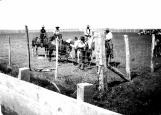 Credits:
Credits:Photographer: Sterrie Lenfesty, Lenfesty Family Collection
25
Johnny Caswell in conversation with Carrie and Brent TroutJune 2005, Drumheller, Alberta
Johnny Caswell: "…rope with it. You'd have to have somebody to teach ya. It's an art and it has to be handed down you know from generation to generation. So it just hung around in the barn there. And one day, they were trying to…somebody bought a young bull from my Dad."
Carrie Trout: "So can you please tell me how you use that rope?…like you said you had to…?"
Johnny: "Oh ya, we hung it around the horn and… on the saddle and we used it to persuade the bull to come home…when he got out on ya."
Brent Trout: "…the difference is that you have to let the rope run. When you rope something, you cannot just 'sally up' and turn your horse off and then your horse is stopped. You have to keep leading the same and you've gotten it tied to the horn. Now our horns are wood and smoke, but on a Mexican harness it's pure wood. Right?"
Johnny: "Yup. Smoke..."
Brent: "…maybe some hide..."
Johnny: "When I start 'smoking'...I ease off. And then, it's just like fishing you play it. And you play it and play it until the animal gives up then you lead him where you want to go. See the Mexicans will take…and the Spanish will take this rope and tie it around their neck. And rope a galloping horse by the front feet."
Brent: "Ya, ya, that's a…"
Johnny: "And I've seen 'em do it. And they'll throw themselves and throw that rope and pull that slack, throw themselves over backwards and that horse will hit the end of that rope and he'll...some of them are a fair size and they'll lift them right off the ground and drop them back.
But he's down when he does that, 'cause his legs are crossed. They catch them so they cross their legs almost every time. But, oh the practice that goes into that. You know, they…they start those kids as soon as they're big enough to swing a rope. And they follow the dog and they follow the cows and they follow the calves and they follow the roosters. And they pick up their…pick up their feet you know."
27
John Shields in conversation with Carrie TroutJune 30, 2005, Hanna, Alberta
John Shields: "And, all the horses there, there's probably 60 or 70 head of horses in that corral.
But what Dad and the buyers would do, is go out and buy all these horses. And, the good horses, we bring 'em in and break 'em to drive and ship the good horses down to Montreal. And, or Quebec, some of those places in Quebec and they would go out into the woods and be horses that they used for pulling logs in.
And, when to break those horses, you put a trip rope on them. And, I usually had to run the trip ropes and there was another cowboy, driving 'em.
And, I remember one time, I pulled on the trip ropes and this horse lit into bucking. Because you put a rank bronc alongside of a broke horse and they would just start to buck and you'd trip them a little bit and let 'em land on their nose. And, then they would quit bucking and then you could ride them.
And, anyhow I pulled on the trip ropes this day and the trip ropes broke. And, away went that team and there was a fence lying, oh just thirty feet wide or so that was a half a mile long. And, the guy that was driving the team, the horses were just bucking and running. And, he'd have to slap one on the rear end if it got this way so they'd cut towards the fence or slap the other one, so they'd pick up speed and finally we'd get out into the open field and circled them until they slowed down.
And, it was a lot of fun and pretty wild breaking those horses and that was going on every day for about five years."
